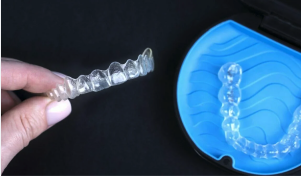“Invisible” orthodontic treatment used to be something that was only available when you visited the dentist, but over the last few years there has been a rise in “DIY dentistry” and at-home aligners treatment.
Whilst this cheaper alternative to Invisalign might be an attractive option to anyone looking to get a straighter smile without spending a lot of money, it doesn’t come without problems.
Read on to find out about the risks of at-home aligners, and get all the information you need before ordering your set.
How do at-home Teeth Aligners work?
At-home aligners work very similarly to the Invisalign aligners provided in a dental practice. Before getting the aligners, you need to get impressions of your teeth made; this will determine the shape of your aligners and your overall treatment plan. This is done by either by visiting a specified clinic or by using an at-home impressions kit.
Once your impressions have been received, your aligners will be created in a remote lab and sent to you, along with a treatment plan to follow. Read on to find out more about how at-home aligners work.
What are the down sides of at-home aligners?
Though this process is said to save time and money, there are many downsides to using at-home aligners:
No Consultation
At-home aligner treatment lacks the personal touch you get when you receive orthodontic treatment from a dentist. Though companies that provide at-home brace treatments tend to have dentists on their team, you’ll only see them at the impressions stage, if you choose to go in-clinic to get them done. Without a full consultation, you might not get all the advice you need in order to get the most out of your treatment.
You also won’t have any mid-treatment consultations or a follow-up appointment when your treatment is complete, meaning you’ll miss out on any support you might need during the process.
Inaccurate Fit
Receiving your aligners in the post means you don’t get to try them on before beginning your treatment, meaning you run the risk of wearing braces that don’t fit your teeth properly. This can lead to a lot of pain and discomfort, and could even mean that, without a dental professional to assess the fit, your aligners might not work effectively.
Not Always Cost-Effective
The biggest pull of at-home aligners is the lower cost. But if your treatment doesn’t go to plan, you may have to visit an orthodontist anyway, which will incur more costs further down the line.
Risk of Damage
Orthodontics is a complicated business, which is why it’s important to seek the help and advice of an experienced dentist before undergoing treatment. Without the supervision of an orthodontist, there’s a chance you might accidentally harm your teeth and gums.
Problems to be aware of include root damage, gum recession and loosening of the teeth.
Ollie & Darsh are Here to Help
Before you decide on any type of orthodontic treatment, you should always thoroughly research each of your options to ensure you choose the system best suited to your needs. So, if you’re considering getting Invisalign or another type of at-home aligner, be sure to contact us first. We can help you understand the risks and make an informed decision about whether this treatment is right for you. Thanks for reading about the dangers of at-home aligners and all you need to know about them.
Here at Ollie & Darsh, we offer a free consultation to anyone interested in brace treatment, so if you’re after a straighter smile, please don’t hesitate to get in touch! Our friendly team are always on hand to answer any questions you may have.

